Paddle Boarding for Beginners: SUP Tips and Gear
Want to try stand up paddleboarding this summer? Learn the basics of SUP with our paddle boarding for beginners guide including tips and gear!
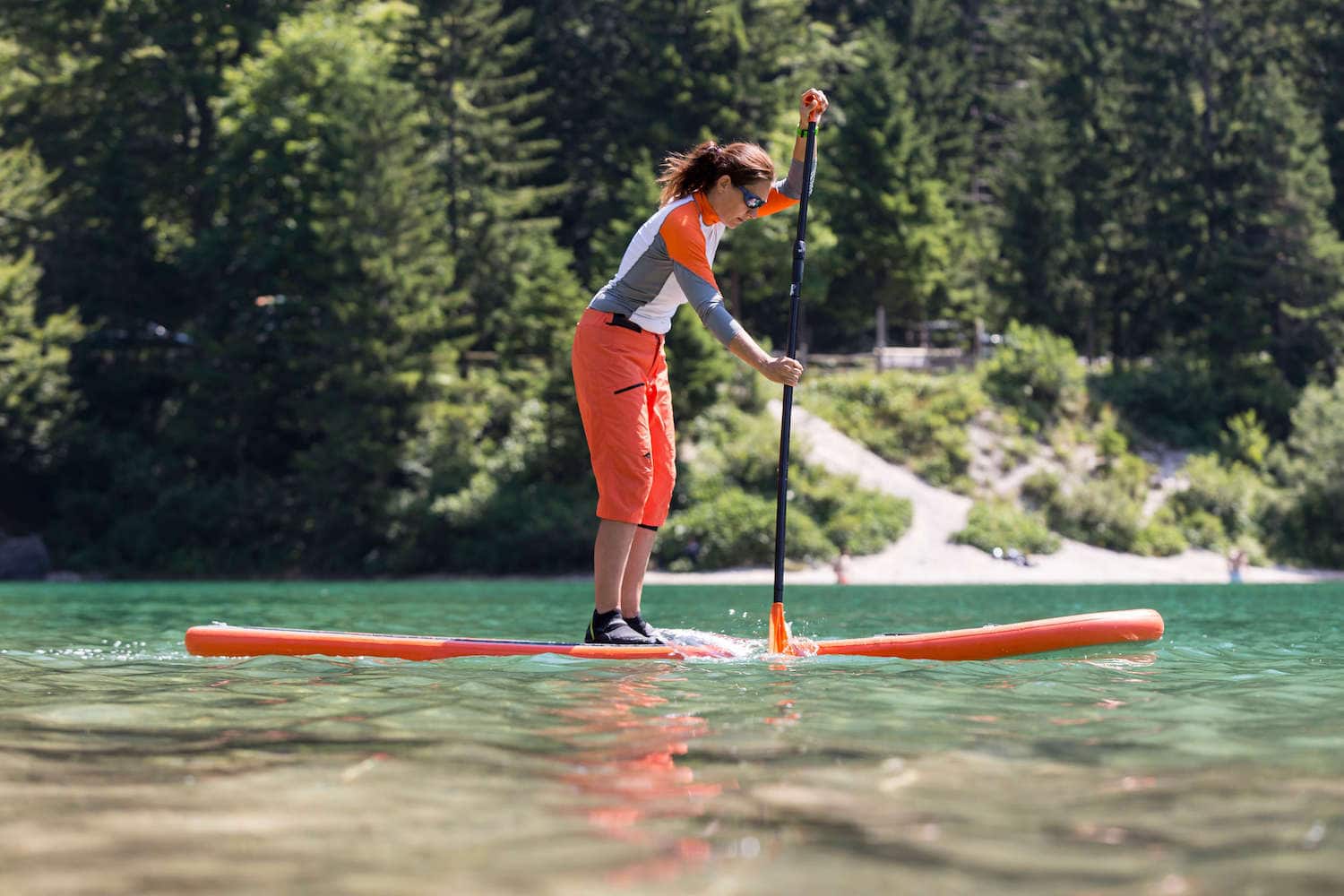
Paddle boarding (also known as SUP-ing) is a great way to get outside and enjoy the sun and water. It’s also an excellent form of exercise, especially for the core. But paddle boarding for beginners can be daunting to know where to start.
This blog post will give you SUP tips and gear recommendations for beginners. So whether you’re looking for your first board or just want to know how to stay safe on the water, read on for some essential SUP advice. Happy paddling!
This post may contain affiliate links.
Looking to try out SUP? Read our complete paddle boarding for beginners guide below!
Important Reminder: As outdoor recreationists, it’s our responsibility to know how to recreate responsibly on the water whether we’re kayaking, paddleboarding, canoeing, rafting, or boating. Learn how to prevent the spread of aquatic invasive species with 3 easy steps that have a huge impact on our ecosystems.
What Is Stand Up Paddle Boarding?
Stand-up paddle boarding is a water sport that allows you to explore and enjoy the water without necessarily swimming in it (although you can definitely do that, too!). Unlike canoes and kayaks, paddle boards are completely flat boards that you can stand, kneel, or sit on to paddle.
SUP paddles are similar to canoe paddles with a blade on one end and a handle on the other, but they are longer than your typical canoe paddle so you can fully stand comfortably.
Paddle boarding has gained popularity in the last few years because it’s a relaxing, fun, and engaging way to paddle across various waterways including lakes, oceans, bays, rivers.
You can also do other activities on a paddle board like SUP yoga or surf some waves.
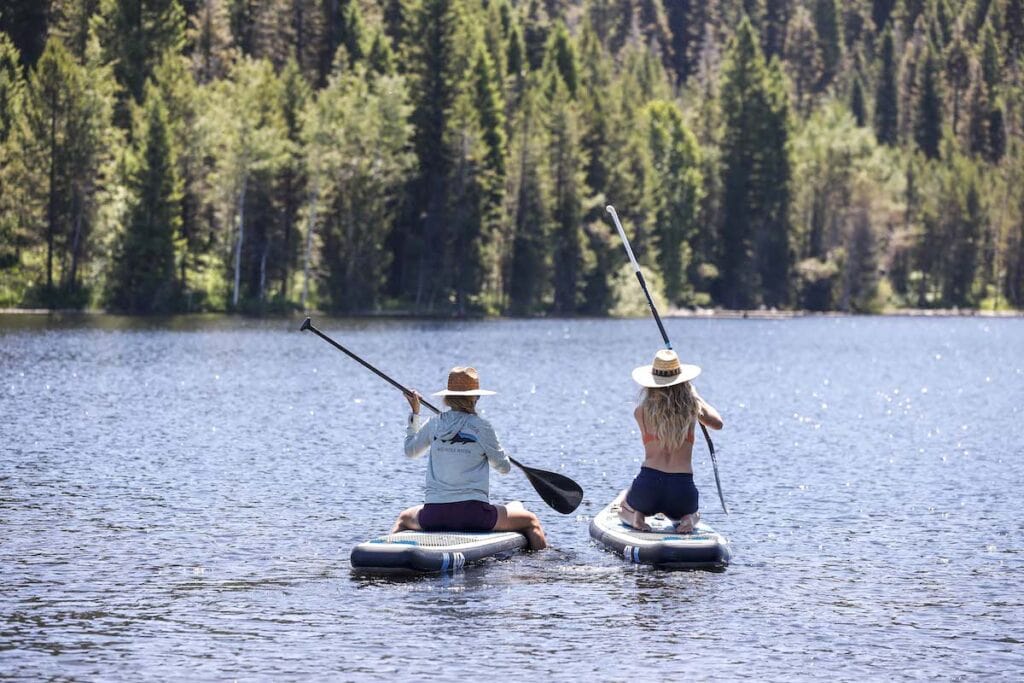
Save this post!
Enter your email & I'll send this post to your inbox! You'll also receive my weekly newsletter full of helpful advice for planning your adventures.
How To Paddle Board
Learning how to paddle board properly is essential for maximizing power and torque out of each stroke as well as improving your balance. This will increase your paddling speed and give you more of a workout. By learning the proper technique, you will also have better control of the board and be able to maneuver more effectively. Below are a few paddle boarding beginner basics:
How To Stand On a Paddle Board
- Stand next to the board in shallow water. Keep an eye on the fin so it’s not dragging on the bottom.
- Place your paddle down across the board
- Attach the ankle leash if there is one
- Plant your hands firmly on the paddle and kneel on the board just behind the board’s halfway point
- When you feel like you are balanced, slowly stand up
- Position yourself so you’re standing at the center of the board – it should be flat on the water with neither the nose or tail lifting up or pushing into the water
- Your feet should be facing forward about hip-distance apart or wider with knees slightly bent
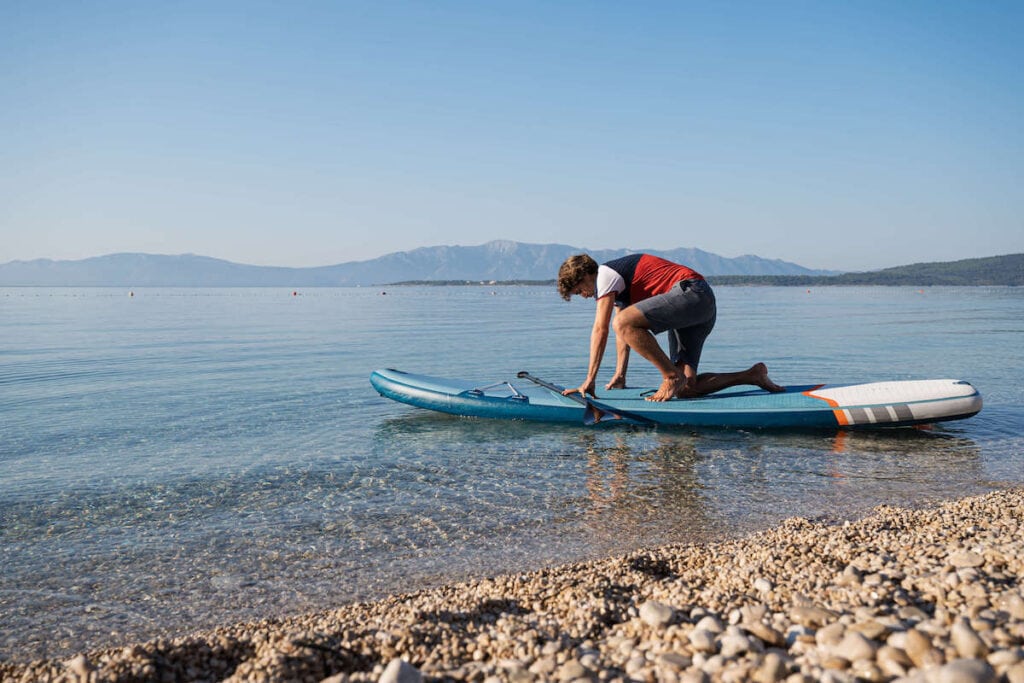
How to hold a paddle board paddle
- Grip the T bar at the top of the paddle with one hand and place your other hand at a comfortable distance about halfway down the paddle
- The angle in the paddle blade should face away from you, which is the opposite of how you would hold a kayak paddle.

How To Paddle a SUP
- Keep your core engaged to help with your balance
- Keep your arms straight as you extend the paddle forward for each stroke
- Make 4-5 short, close strokes on each side of the board and then switch sides and reverse your hand positions
- To turn, keep paddling on one side (paddling on the right will cause you to go left). Or for a quicker turn, drag your paddle backward on the side you want to turn in the direction of
- To watch a video on how to stand up on a paddle board, click here.
The best thing about paddle boarding versus kayaking or canoeing is that you have many options for how to paddle. While we outline how to stand up on a paddle board above, you can also paddle board while kneeling or sitting on your board.
Beginner paddle boarders can feel out what works best for them or what is most comfortable. Once you’re out on the water, you can even lie down on your paddle board to relax! Another helpful option is a packable chair that you can use to sit on a paddle board and paddle kayak style if you feel fatigued or are struggling with balance while standing.
Types of Paddle Boards
There are two types of paddle boards: solid and inflatable. If you are renting a paddle board, it will likely be a solid SUP. However, inflatable paddle boards are gaining popularity for their affordability, packable size, and versatility. Here are a few key differences between solid and inflatable paddle boards:
Solid Paddle Boards
- Pros: best performance on the water, no time to set up, more stable, less effort to paddle, easier to custom fit
- Cons: More challenging to store and transport
Bearfoot Theory Pick: Surftech Bark Catalyst Tuflite V-Tech Stand Up Paddle Board
The Surftech Bark Catalyst Tuflite V-Tech Stand Up Paddle Board is a great choice for entry-level paddlers because it is super stable, durable, and versatile. Whether you want to take it out on a lake, down a river, or even in the ocean, this board will keep you feeling comfortable and secure.
Check price: REI
Inflatable Paddle Boards
- Pros: easily stored and transported, softer and more comfortable to sit or do yoga on, can paddle more places (like a short hike to a lake), better suited for rapids
- Cons: inflating and deflating is time-consuming, less stability
Bearfoot Theory pick: Bote Breeze Aero Inflatable Stand Up Paddle Board
The Bote Breeze Aero Inflatable Stand Up Paddle Board is our top choice for an inflatable SUP. Designed to be packable and lightweight, it’s the perfect board for water-focused adventures. When packed away in its own backpack, it weighs just under 22 lbs and can easily be carried on a short hike or stowed in the back of your car.
Check price: REI | Backcountry
Stand Up Paddle Board Features
Planing hull vs displacement hull
You should choose your paddle board based on the kind of activities you plan to use your board for and what kind of water you will be paddling on. There are two body types for SUP boards:
- Planing Hull: wide, flat body with a rounded nose. Best for leisure paddling, SUP yoga, surfing, and whitewater.
- Displacement Hull: narrower body with a pointed nose. Best for fitness paddling, long-distance or overnight paddling, and racing
For most beginner stand up paddlers, finding a board with a planing hull is best because the wider width gives more stability so you can focus on the correct paddling stroke without the constant concern of falling in the water.
Weight capacity & length
Other factors to consider when renting or buying a paddle board are weight capacity and length. It is important to calculate the total weight on your board (including gear, any pets, food, etc.) to ensure your board will sit high in the water and you will be able to paddle easily.
Paddle boards usually come in 3 lengths: short boards (under 10′) are best for children or surfing, medium boards (10-12′) are best for leisure and everyday paddling, and long boards (over 12′) are best for long-distance and fitness paddling.
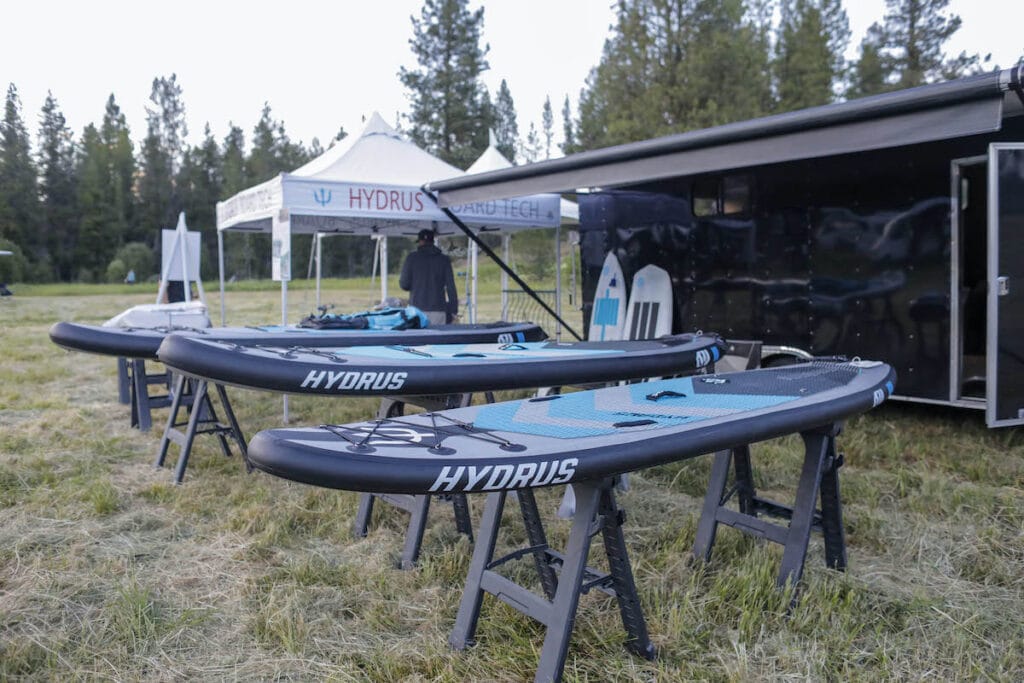
Beginner Stand Up Paddle Boarding Tips
Now that you have a better understanding of what paddle boarding is, the different types of paddle boards, and how to choose the right one for you, let’s dive into some paddle boarding tips:
1. Check Conditions
This is an important step before venturing out for any SUP adventure. Make sure that conditions are safe and fit for your ability so you can have an enjoyable time. Flatwater (a lake or a bay) is best for beginners versus moving water in the ocean or on a river.
I also recommend picking a calm, sunny day with little to no wind – mornings and evenings usually have calmer waters. If you are planning to paddle board in windy conditions, pick a spot where the wind will be at your back on your way back in so you are not fighting against the wind when you are more tired. If you ever get caught in a windstorm, lay down on your stomach with your paddle underneath you and paddle like you are on a surfboard.

2. Take a Buddy
If you are brand new to paddling, bring a friend! This will not only enhance your enjoyment out on the water but also creates a safer learning space. Try to pick a spot that is not crowded by boats, buoys, or other obstacles in the water.
Do not plan a long trip for your first outing – paddle boarding is a full-body workout, and you may be surprised at how sore you are the next day!
3. Always Use a Leash
A paddle board leash loops around your ankle and keeps you attached to your board. Let’s face it – at some point, you might fall off your paddle board (and that is part of the fun of water sports!). To ensure you stay close to your board and can easily retrieve it, always use a leash.
There are different leashes for different types of paddleboarding activities, so be sure to buy the correct leash.
4. Use Your Core
Don’t rely on your arms to do all the paddling – this is the quickest way to tire yourself out! Be sure to keep your core muscles engaged to even out how hard your body is working while paddling. Stand up tall while on your SUP. Your large back muscles should be doing the bulk of the work and be sure to also dip your blade fully into the water with each stroke to get the maximum resistance.
5. Consider Taking a Paddle Boarding Lesson
Whether you are just learning or an experienced paddler, there are always new techniques that can be picked up to enhance your paddling experience. Guided paddle boarding trips mean more structure, less planning, and a safe group to explore with.
I highly recommend taking a lesson before paddle boarding in the ocean or if you plan to do long distance SUP trips.
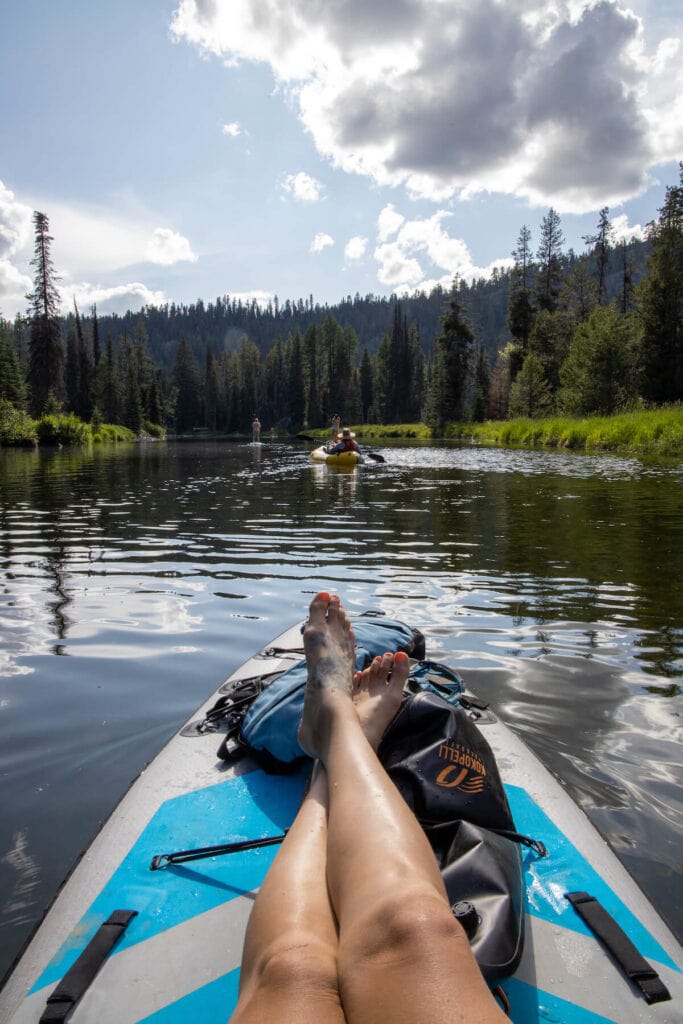
Paddle Boarding Gear
What to Pack for Paddle Boarding
If you are just beginning to learn how to paddle board, it’s best to rent gear or borrow from a friend. Paddle boards are an investment, so you should make sure you enjoy it before pulling the trigger on buying one.
Here is our recommended list on what to pack for paddle boarding:
- Personal Floatation Device (PFD)
- Leash – always use a leash to ensure you stay close to your board in the event you fall off
- Paddling gloves – if you plan to SUP long distances or are prone to blisters
- Dry Bag – to keep all of your gear protected since it will be sitting on top of your board
Besides the absolute basics listed above, we also recommend packing the following for paddle boarding:
- Reusable Water Bottle
- Camera – a GoPro is the perfect waterproof camera
- Carabiners – some paddleboards have bungee straps so you can easily strap down your gear. We also recommend attaching a carabiner to anything important (like your dry bag, portable speaker, etc.)
- Sunscreen
- Lip Balm with SPF
- Snacks
- Quick Dry Towel
- Waterproof Portable Speaker – who doesn’t love listening to tunes while on the water? Just be respectful of other people and remember that sound carries over water.
- Garmin inReach Mini – I always recommend carrying an emergency communication device if you are out of cell range
What to Wear Paddle Boarding
Since you’ll likely be getting wet, you want to stay away from anything cotton which will leave you dripping and soggy all day. Assuming it’s warm and you don’t need a wet or dry suit of any kind, you’ll want lightweight, quick-drying layers – like a rash guard and boardshorts – which also provide sun protection.
Here is what we recommend you wear while paddle boarding:
Essential Clothing for Paddling
Goodr Polarized Sunglasses
Polarized glasses are best for the reflection of the water. I like to wear budget-friendly sunglasses paddling and I always wear a retainer so I don’t lose them in the water.
Shop at:
We hope these beginner paddle boarding tips inspire you to try SUP for the first time this summer. What questions or tips do you have? Leave them in the comments below!

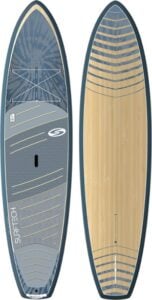

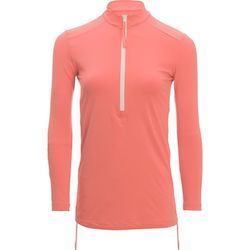
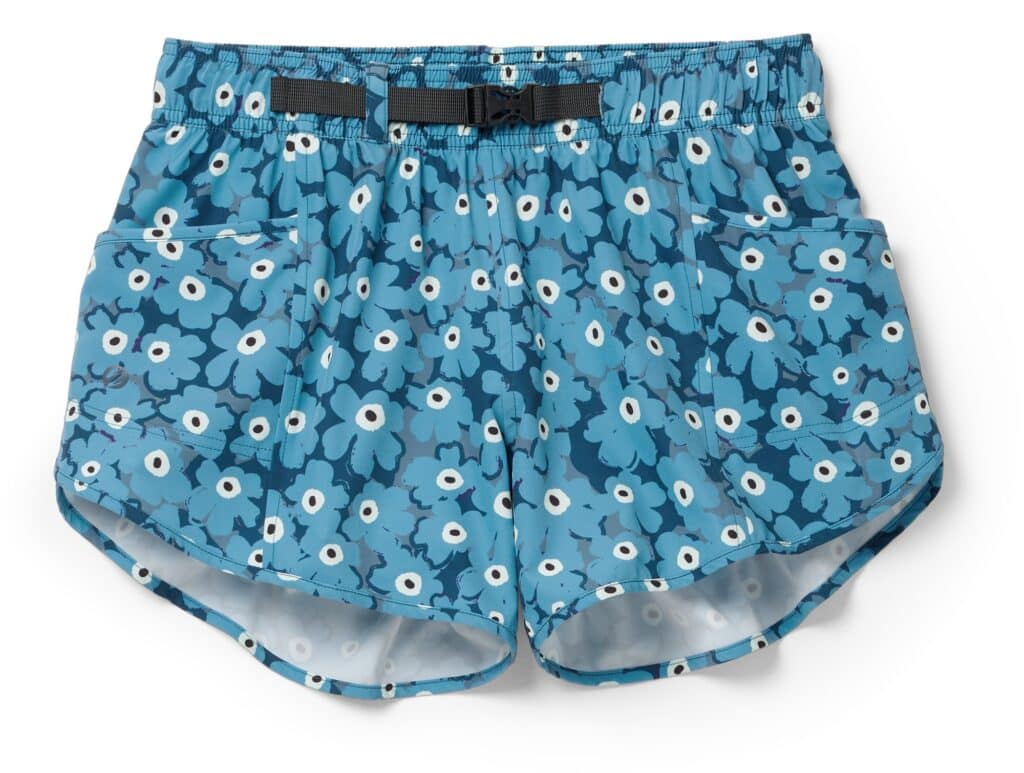
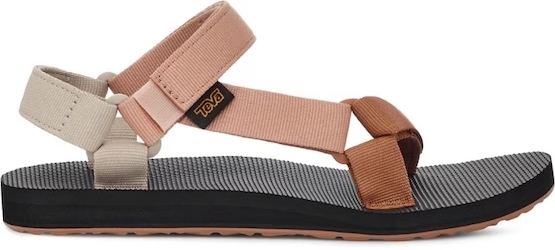
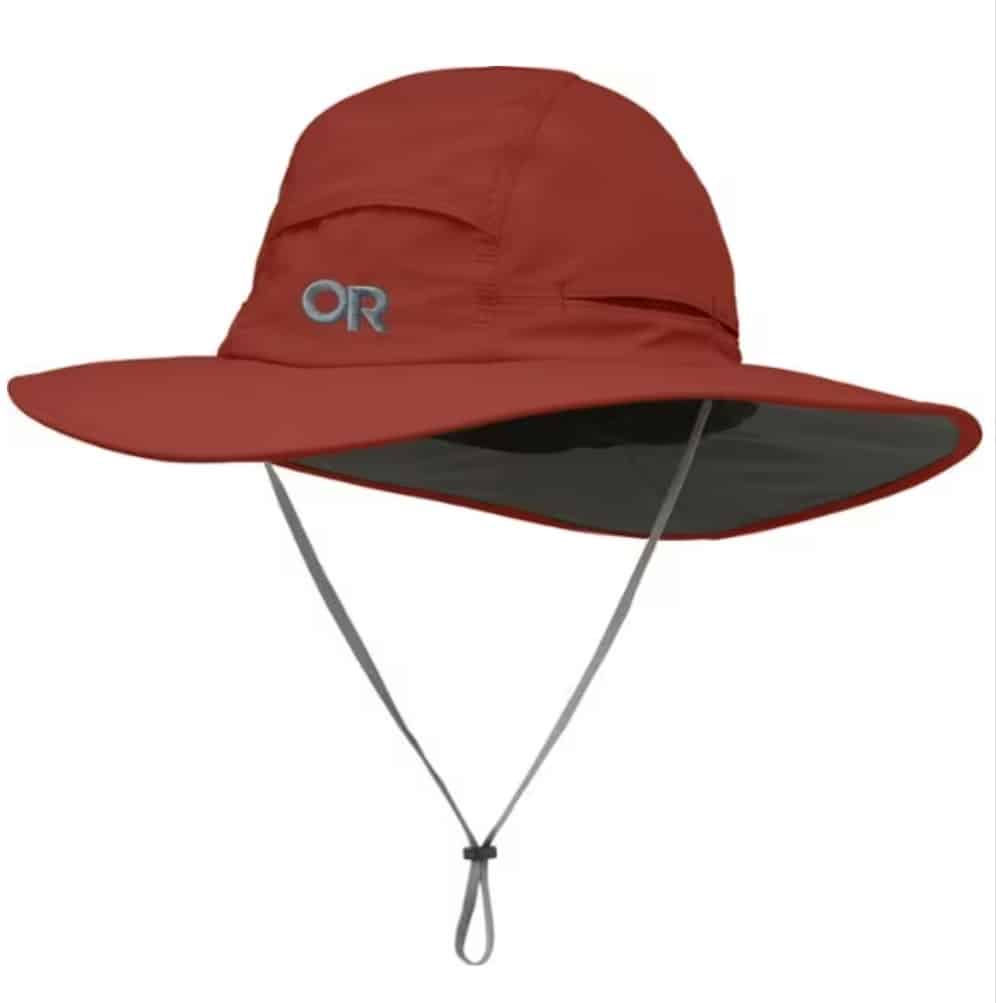
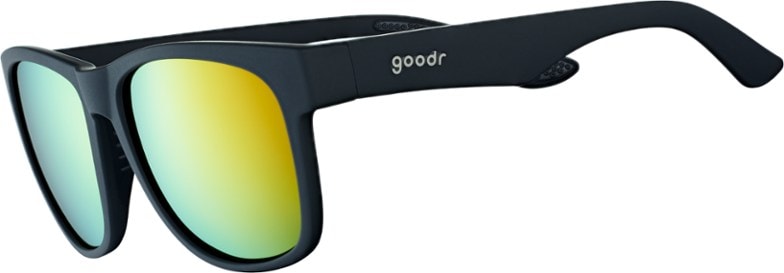
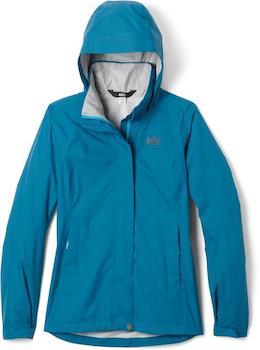


I’ve always been intrigued by stand up paddle boarding, but have been a little too afraid. You have made it seem a little less scary, and I will have to look into a short class or clinic. Thanks for your tips!
Go for it Laurie! My motto is to always try something once. If you decide you don’t like it, then you never have to do it again…but maybe you’ll find a new favorite hobby. Come back and let me know how it goes!
Hey, great share……
There has been a real surge in the popularity of stand up paddle boarding in the last few years. If you’ve never been on a stand up paddle board (SUP), it can be hard to understand the attraction.It is incredibly fun. Stand up paddle boarding is always more fun with a buddy.
Thanks for sharing these pro tips on SUP . Keep sharing more….
Cheers!!
Thanks Jean! Glad you enjoyed the post.
Really good tips here! I would definitely agree about checking the conditions. I remember when I thought it would be fun to take a surf lesson in Surfer’s Paradise, Australia. It was very windy and the waves were pumping. Great news for people who already know how to surf, not so great for us beginners trying to learn 🙁 I spent more time chasing my board as it rushed towards the beach getting carried by a wave than actually learning anything about surfing.
On the contrary, when I did a couple windsurfing lessons, it was in a nice, calm protected bay which made learning actually quite fun and easier than expected. So learning in the right conditions matters!
Hey, really like this post! I love getting out on the water with my dog. I’ve tried kayaks and canoes, but paddle boarding is certainly the best for my pooch! The traction platform really makes it ideal. Thanks for the post!
Paddle boarding has also been a hard sport for me. I love it I just have such awful balance! I am getting better and now my husband and I go almost every weekend! Thanks for sharing such a great article.
Nice post and paddle boarding is my favorite game.
Thanks! It’s fun isn’t it 🙂
My fiancé bought me a SUP for Christmas! I’ve only rented ones in the past and have only boarded a few times. This post was extremely helpful! I should be doing yoga on it in no time LOL
Great post, Kristen — I’m very excited to hear that you enjoyed your first paddle and hope that you continue with the sport. There are few activities that match stand up paddleboarding when it comes to health benefits and immersing you in natural beauty. Another thing that makes it so amazing is that anyone can enjoy paddleboarding, regardless of age or experience level.
There is one critical thing that I wanted to mention which was not covered in your post — the importance of wearing a SUP leash. In certain conditions, falling off of your board without a leash can easily result in death as wind, waves, and currents can quickly separate you from your SUP. A SUP leash is an inexpensive and unobtrusive accessory that you should wear every time you paddle out, and they save lives.
I did a detailed write-up listing this year’s best SUP leashes, perhaps you will find it helpful:
http://www.inflatableboarder.com/best-paddle-board-leash/
Thanks again for sharing your first SUP experience and for the great tip list, Kristen. It’s super exciting to see so many trying our sport for the first time and I’m happy to hear that you had a great experience!
Happy paddling!
-Jason
I have been really interested in learning how to use a stand-up paddleboard. I liked that you talked about how if it is windy out it might not be a great time to go paddle boarding. It might be a good idea for me to see if there are any places where I could rent some gear and get lessons. Then I could understand how to tell if conditions are good to go out.
Great tips, especially enjoyed the tips on how to get up, that seems to be the most difficult part for a beginner:). I was wondering if the subject of inflatable SUPs came up during the class? I have been doing some research and it seems to me an inflatable paddle board is much easier to transport and store, not to mention most cases cheaper than a regular SUP.
Anyway just wanted to ask, hope you are still enjoying paddle boarding, Huntington Beach and Manhattan Beach are my two favorite spots in California by the way:)
Hello! Kristen and I both have actually been looking into getting inflatable paddle boards. Kristen already has an Oru Kayak that travels with her on the top of her van but having more than one water toy is always fun! I live in Santa Barbara and I am looking into getting one so I can paddle weekly.
Hey Ozzie. Yes, inflatable SUPs definitely offer a lot more convenience when compared to rigid boards. They’re super easy to store, transport, and you can even check ’em with your luggage when flying.
Over the past few years, inflatable construction technology has improved and the best iSUPs on the market right now are nearly as stiff as hard boards. Rigid boards do offer a slight advantage when it comes to performance, although this gap continues to get more and more narrow.
For the vast majority of paddlers, an inflatable is the way to go. If you’re getting involved in SUP competitions, however, I’d still recommend a hard board.
Hope this helps! If you have questions on specific inflatables or need help in any way, feel free to reach out. I review a lot of inflatables and I’m happy to help you however I can. By the way, I wrote an article last year comparing inflatables and hard boards, perhaps it’ll also be helpful for you to check out: https://www.inflatableboarder.com/inflatable-paddle-board-vs-hard/
Happy paddling.
I would like to try paddle boarding someday 🙂
looks like a good workout.
x
Super post Kristen,
Would you say your baseline fitness was instrumental in you getting off to a good start paddle boarding from your lesson?
I am often asked the level of fitness required of a beginner before he/she can start paddle boarding.
I am not sure of the right answer and would like to know your thoughts on this.
Cheers,
Bob
Hi Bob, great question! As a former guide for an outdoor adventure outfitter that offered all types of SUP tours, I think being agile, flexible and having good balance is instrumental in having success with paddleboarding. Can almost anyone give it try? For sure! Is it difficult and does it require a minimal level of athleticism, yes, I’d say so.
Great tips! For me the biggest revelation when I started learning to SUP was the realisation that you should put your paddle in the water and pull your body through the paddle, rather than pulling your paddle towards you with your arms. What a difference! Makes for a great core workout too!
That’s exactly what I am looking for. Thanks for this post. I love your blog and all the ideas you shared about outdoor experiences. Keep it up!
Thanks for sharing practical tips on stand-up paddle boarding. I find the tips quite interesting and I cannot hesitate to share them too. Keep up the good work.
Nice beginner guide. Looks promising to me. I was exactly looking for the same paddle boarding guide. Thanks, dude for your efforts.
While paddling the surfboards there is few things which you should keep an eye on that to avoid any miss happening, first of all you should choose the right equipment according to your size and ability. While in the learning phase you should always borrow the paddle boards so that you should be able to learn well without any difficulty and always take the lessons from the expert
Hey, I have never paddle on sup board. Im 5.5 ft and 145 lbs. Dont have feeling to choose right board for me. Can you recommand me a board ? I prefer lakes and rivers.
Hi Marko! Thanks for reaching out. We recommend heading into REI so they can support you in picking a board that is perfect for you & for what you are looking to do!
Really good tips here! I would definitely agree about checking the conditions. I remember when I thought it would be fun to take a surf lesson in Surfer’s Paradise, Australia. It was very windy and the waves were pumping. Great news for people who already know how to surf, not so great for us beginners trying to learn I spent more time chasing my board as it rushed towards the beach getting carried by a wave than actually learning anything about surfing.
On the contrary, when I did a couple windsurfing lessons, it was in a nice, calm protected bay which made learning actually quite fun and easier than expected. So learning in the right conditions matters!